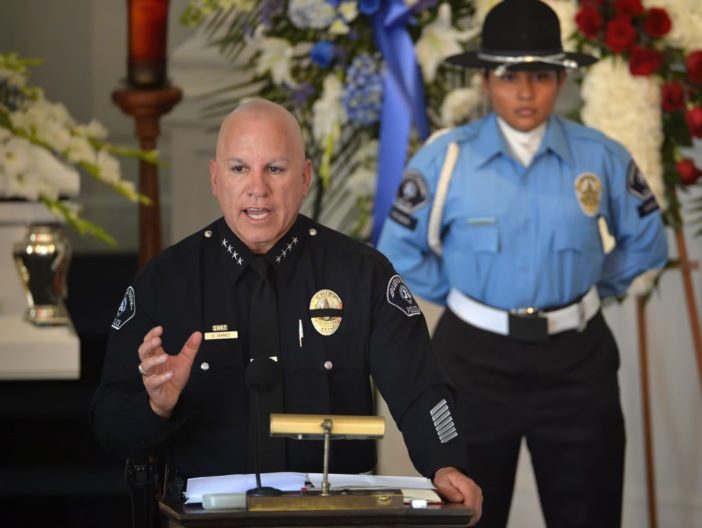Buena Park Police Chief Corey Sianez has never been afraid of hard work.
His “leave no stone unturned” attitude came early when he was just a kid working as a brick layer in 115-degree California summers.
This same work ethic would follow him into his career in law enforcement and later as a detective where his dogged police work would help solve a murder that most deemed at an impasse.
But Sianez joined the police department to catch the bad guys – so that’s what he did.
He has spent 40 years at Buena Park Police Department where he was plucked from Golden West Police Academy just a week before graduation. He never left, never felt the need to move to another Department when there was plenty of work to do in Buena Park.
During his nearly four decades long career, Chief Sianez has worked in patrol, detectives, and spent a big chunk of his career working on the Department’s SWAT team.
He has seen the community and Department evolve, along with his Sam Brown police belt that once carried a baton, a couple of handcuffs, a revolver and in a pocket Sap gloves.
These days, tasers and pepper spray have replaced Sap gloves, semi-automatic handguns replaced the revolver, and body cameras are now an intrinsic part of the uniform as well as police culture.
“Cops are not always comfortable with change,” Chief Sianez says. “But I think we all realize now how much (body cameras) help us out. Our complaints are down 75 percent. Cameras make the community members act different and the police officer.”
“We realize now, change is good.”
In North Orange County, change is afoot once again as the homeless community continues to grow and technology and community partnerships offer new tools to help transition people experiencing homelessness into housing instead of jails.
Sianez along with a handful of police chiefs from the surrounding communities of La Habra, La Palma, Anaheim, Brea, Cypress, Fullerton, Orange, Stanton, Yorba Linda and Placentia have spent the last four years as advisory board members of the North Orange County Public Safety Task Force, a group formed in 2017 by the State Legislature Assembly Bill 97 (Ting, 2017). Sianez is leading the group.
The goal was to reduce youth violence prevention, promote successful re-entry of offenders into the community and address homelessness and intervention through collaboration between police, community-based organizations, and other stakeholders.
“In 2017 we were fortunate to get $20 million from the state to create a regional approach to address these three areas,” said Chief Sianez. “We got all the chiefs in the region together as members of the board and what we found is that we were doing things individually – rather than together. Turns out we could do a better job … together.”
They are getting promising results. Hundreds of people have transitioned off the streets and the data is pointing toward positive outcomes in reduced violence. Sianez and others believe the approach is worth copying throughout California.
“With Chief Sianez as our Chair, the North Orange County Task Force has seen much success for the past four years. Corey’s inclusive and visionary leadership has created a synergy between a wide range of service providers and community-based organizations to effect positive sustainable, and measurable outcomes in our key focus areas,” said Fullerton Police Chief Bob Dunn.
When the task force was first formed, the first thing it decided to do was to help identify how big the homeless community was in the region. This prompted the first Homeless Census, which was led by the police departments, volunteers, and local community-service groups. With the Census, the group knew the names of each individual, how long he or she had been living on the streets, when and where they were last housed and more.
Armed with the information, the task force partnered with a technology company to create an app that makes providing services quick and seamless.
“The in-depth homeless count was important because we needed to know who was out there and how to address it,” said Chief Sianez. “But then we realized we needed a technology tool, and we found a small start-up company called Outreach Grid, that helped us create something to help our outreach workers. It has been huge, huge accomplishment for us.”
The application can be easily downloaded onto a phone and allows police officers, community service workers and volunteers to share information on beds available at a local shelter, as well as access mental health services, employment) and any other housing services.
“It’s so efficient for our officers and through the application we have been able to see what a significant impact we’ve had,” Chief Sianez said. “Before the Task Force, our officers would not spend time to find resources, it was more of a quick solution, we would say ‘hey you gotta get up and move somewhere else,’ but now our goal is proactive.”
The app also provides a uniformed metric to refine their services and approach. It’s been hard work and required a change in thinking and approach, something Sianez is comfortable with in nearly four decades of police work.
“Our ultimate goal is to eliminate homelessness, which is a pretty lofty goal, but if we can work together … there’s some great ideas that have come from it,” he said.
,
 Behind the Badge
Behind the Badge



